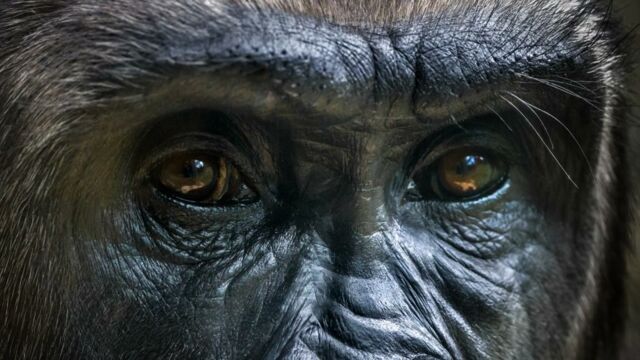5 things you need to know about the gorilla, the largest of all primates

The largest primate in existence, the gorilla is an impressive beast. Here is everything you need to know about it.
The different gorilla species
There are two species of gorillas, which are themselves divided into two subspecies. These are:
Discover our latest podcast
- Western Gorilla (Gorilla gorilla): Western Lowland Gorilla (G. g. gorilla), Cross River Gorilla (G. g. diehli)
- Eastern Gorilla (Gorilla beringei): Mountain Gorilla (G. b. beringei), Eastern Lowland Gorilla (G. b. graueri)
Both subspecies are found in Central Africa, in tropical lowland and mountain forests (Democratic Republic of Congo, Rwanda, Uganda).
The gorilla: Big animal, a very small penis
The gorilla is the largest living primate. An adult male can reach a height of 2 m when standing upright, weighing almost 280 kg. However, if there is one place where the gorilla fails to impress, it is in its genitals. The erect penis of a male gorilla is only 3 to 5 cm long. It is the smallest penis of all apes, proportionally speaking.
More under this adMore under this adThis can be partly explained by its lifestyle. Unlike other great ape species, such as the chimpanzee or the bonobo, where several males live together, this is not the case for the gorilla. Family groups are composed of a dominant male, called the silverback, several females and young.
In addition, as females only have a calf every four years or so, there is little mating.
Why does the gorilla beat its chest ?
Everyone is familiar with the images of King Kong, the giant gorilla, furiously pounding his chest with his fists. But why does the gorilla beat his chest in this way? In truth, this behaviour is mostly done by dominant male gorillas. Scientists have long believed that this drumming, which can echo up to a kilometre through the thick rainforest, is a way of attracting females and intimidating potential rivals.
More under this adMore under this adBut in a recent study, experts also realised that male gorillas beat their chests to give information about their own physique. Larger gorillas, with larger air sacs near their larynxes, produce chest beats at lower frequencies than smaller ones.
The information would allow partners or potential rivals to judge their size from a distance, and thus avoid duels in a dense forest where it is often difficult to see each other.
More under this adMore under this adDoes the gorilla climb trees ?
With prehensile thumbs on its hands and feet, the gorilla is technically capable of climbing trees. However, as an adult, its weight and massive build mean that it spends most of its time on the ground.
This great ape only climbs trees to sleep on the lowest branches or in case of danger.
Why is the gorilla threatened?
Gorillas are among the most endangered animals. The Western and Eastern Gorillas are classified as Critically Endangered on the IUCN Red List.
More under this adMore under this adLike many wild species, they are facing habitat loss. Forests are disappearing, and they are also being poached and traded illegally, killed for their meat or body parts used in traditional medicine, or as trophies, or amulets.
But it doesn't stop there. As we know, great apes have many similarities with humans, starting with their DNA. The gorilla has 98.47% of DNA in common with us. As a result, this threatened great ape is particularly susceptible to the same diseases as humans. Since the 1990s, for example, the Ebola virus has decimated a third of gorillas and chimpanzees. According to experts, a simple cold is enough to kill a gorilla.
More under this adMore under this adWhile the world is suffering the full force of the COVID-19 pandemic, the gorilla, like humans, has not been spared. Several individuals living in zoos have tested positive. Experts also fear that tourists who go to admire these primates in their natural environment may contaminate them with the coronavirus.